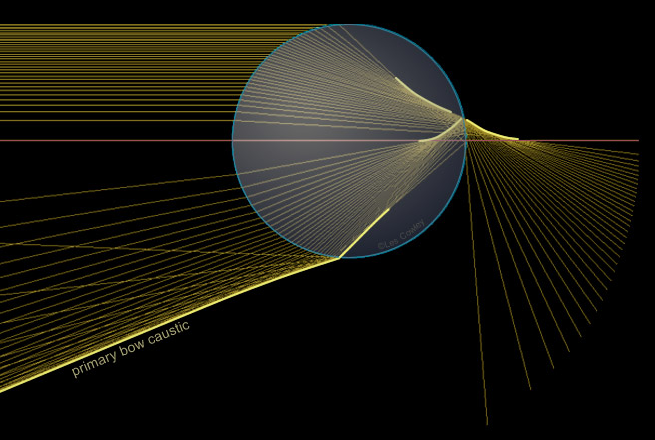OPOD - Rainbow Caustics
OPOD - Rainbow Caustics: Unveiling the Intensity and Sharpness of Rainbows
Rainbows have captivated humans for centuries with their vibrant colors and ethereal beauty. We have long understood that rainbows are formed through the reflection of sunlight inside raindrops. However, this explanation alone does not account for the incredible intensity and sharpness that we observe in rainbows. To truly grasp the magnificence of rainbows, we must delve into the fascinating world of rainbow caustics.
Understanding the Phenomenon
When sunlight enters a raindrop, it undergoes multiple internal reflections before finally emerging. These internally reflected rays scatter in various directions upon leaving the raindrop. However, it is the convergence and clustering of these rays that give rise to the extraordinary sharpness and intensity of rainbows.
The Intricacy of Caustics
Caustics are regions in space that mark discontinuities in the behavior of light rays. In the case of rainbows, the internally reflected rays cross and cluster together, forming a caustic sheet. This sheet exhibits an infinite intensity classically associated with caustics. The concentrated light on one side of the caustic creates a mesmerizing display that quickly diminishes in intensity as we move away from it.
Unveiling the Rainbow Caustic
The primary rainbow caustic takes on a conical shape, with a half angle of approximately 42°. This cone represents the convergence of internally reflected rays that contribute to the primary rainbow. However, this is not the only caustic present within a raindrop. Additional caustics, depicted as thick yellow lines in images, form surfaces of revolution around the red axis.
Rays Without Reflection
While many rays undergo internal reflection within a raindrop, it is important to note that most rays pass through without being reflected. These non-reflected rays cross close to the surface of the drop and then diverge, failing to form a distant caustic. Consequently, these rays do not contribute to the formation of a rainbow. Instead, they create a soft zero-order glow around the sun, adding to the atmospheric spectacle.
A Visual Delight
Rainbow caustics unveil the intricate interplay between light and water droplets, allowing us to witness the true magic of rainbows. As sunlight interacts with raindrops, the convergence and clustering of internally reflected rays create intense bursts of light that captivate our senses. The resulting rainbow caustic, with its sharpness and vibrancy, stands as a testament to the awe-inspiring wonders of nature.
Exploring Further
If you would like to explore this topic further, we invite you to visit the original article here. Please note that the article has been automatically converted from the old site and may not appear as intended. However, it provides additional insights into the captivating world of rainbow caustics.
In conclusion, the intensity and sharpness of rainbows extend beyond simple reflection within raindrops. Rainbow caustics play a crucial role in enhancing the visual spectacle by clustering internally reflected rays. As we unravel the intricacies of rainbow caustics, we gain a deeper appreciation for the breathtaking beauty that nature graciously bestows upon us. So, next time you witness a rainbow in the sky, take a moment to marvel at the convergence of light and water that brings forth this extraordinary phenomenon.

Rainbow Caustics ~ Image by Vincent Favre (Photos Crystal de givre) taken at Drôme, Rh�ne-Alpes, France ©Vincent Favre, shown with permission.

To say a rainbow is formed by reflection inside raindrops does not explain its amazing intensity and sharpness because reflected sun rays emerge from raindrops in many directions.
The bow sharpness and intensity arise because the internally reflected rays cross and cluster to form a caustic sheet where classically the intensity is infinite. Caustics are regions of space marking discontinuities in ray behaviour. Crossing rays cluster on one side of a caustic giving intense light that falls off rapidly a short distance from it.
The emerging primary rainbow caustic forms a cone with a half angle of ~42°. More caustics (thick yellow lines at left) are inside the drop. They form surfaces of revolution around the red axis.
Most rays emerge from a drop without being reflected. They cross close to the drop surface but then diverge without forming a distant caustic. These rays give no rainbow, instead they form a soft zero order glow around the sun.
Note: this article has been automatically converted from the old site and may not appear as intended. You can find the original article here.
Reference Atmospheric Optics
If you use any of the definitions, information, or data presented on Atmospheric Optics, please copy the link or reference below to properly credit us as the reference source. Thank you!
-
<a href="https://atoptics.co.uk/blog/opod-rainbow-caustics/">OPOD - Rainbow Caustics</a>
-
"OPOD - Rainbow Caustics". Atmospheric Optics. Accessed on December 22, 2024. https://atoptics.co.uk/blog/opod-rainbow-caustics/.
-
"OPOD - Rainbow Caustics". Atmospheric Optics, https://atoptics.co.uk/blog/opod-rainbow-caustics/. Accessed 22 December, 2024
-
OPOD - Rainbow Caustics. Atmospheric Optics. Retrieved from https://atoptics.co.uk/blog/opod-rainbow-caustics/.